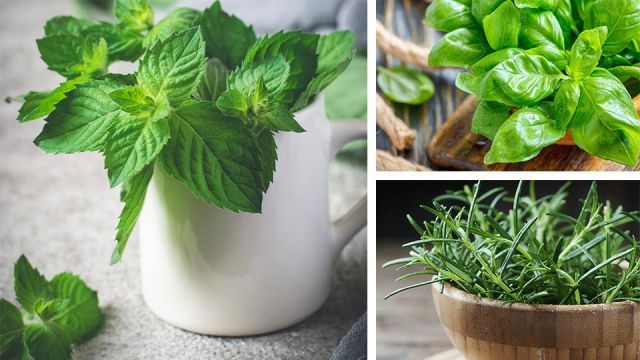
People have been using herbs for thousands of years as medicines, to season meals and (in some cases) to expand minds. Science is confirming that many of these commonly used plants are suffused with ingredients that promote health and well-being on multiple levels. The beneficial things you’ll typically find in herbs include:
- Anti-inflammatory compounds
- Antioxidants
- Phytonutrients
- Tumor-inhibiting and cancer-busting compounds
- Natural antibiotics
- Antiseptic agents
- Compounds that improve your metabolism, promote immunity and stabilize blood glucose levels
Herbal plants are chock-full of flavorful ingredients and medicinal goodness, but there are other ways they can be therapeutic. Growing them inside your home (or as part of your outdoor garden) can be a rewarding hobby that provides endless stimulation while bringing you closer to nature.
Growing your own medicinal herbs at home is simple, inexpensive, very cost-effective, and lots of fun. Here is a list of seven herbal plants you can easily cultivate yourself:
1. Parsley
This is one of the tastiest herbs out there. Its leaves can be used to garnish any type of meal including potato salad, seafood dishes and snack dips. It pairs especially well with omega-3 rich wild-caught salmon, but it’s perfect on just about any meat.
By the way, parsley is loaded with folic acid, antioxidants and volatile oils. It’s frequently recommended for urinary tract infections, indigestion and respiratory problems. If you are growing it indoors, then be sure to use a large pot and keep the soil moist.
2. Mint
Mint has a refreshing taste that makes it a popular choice to season many meals. For a Mediterranean style salad, add it to red cabbage sprinkled with feta cheese. Mint also pairs well with spicy chicken, vanilla ice cream and in a pineapple granita.
Mint is a natural expectorant and is rich in vitamin C, iron and antioxidants. It can help reduce congestion, headaches and abdominal pain. It can also freshen your breath. Mint grows fast and furious, so keep these plants in large sunken pots if you are growing them indoors.
3. Basil
Basil is one of the most popular herbs to use in the kitchen. It’s so flavorful and fragrant that it’s perfect for soups, pesto sauces or as a garnish over appetizers. You can also infuse olive oil with basil, which you can sprinkle on salads or as dip for your before dinner bread.
Basil is a great source of heart-healthy omega-3 fatty acids. In addition to its natural anti-inflammatory properties, it’s also great for treating digestive issues such as nausea, gas and bloating. Basil is averse to cold weather, so be sure to find a nice sunny spot for your plants.
4. Rosemary
Rosemary is an aromatic herb that has a woodsy scent. It has been used for centuries to alleviate muscle pain and improve circulation. Before cooking with rosemary, you’ll need to dry the herb. But once you’ve done that, you can use it in marinated cheese recipes, to garnish meats or to infuse oils and teas.
There is some evidence that rosemary has anti-cancer properties. Traditionally, it’s been used to treat muscle pain, scalp issues (including dandruff) and rheumatism. It is best grown in well-drained and gravelly soil.
5. Dill
Dill has a fresh and grassy flavor that makes it a perfect complement to salads, eggs or cold soups. For centuries, it’s been recognized as a digestive aid (particularly when it comes to reducing gas and bloating).
Dill is also a great source of many vitamins, fiber and numerous minerals. Not surprisingly, there’s evidence that the herb can boost immunity, help prevent colds and offer relief from insomnia. Dill plants thrive on both sun and lots of water.
6. Oregano
Oregano is one of the most popular, versatile and beneficial herbs known to man. The peppery spice can add flavor to almost any meal idea, though it is especially well-suited to Italian cuisine, roasted vegetables and chili recipes.
Oregano is widely regarded as an antioxidant “superfood.” In addition to free-radical scavengers, it is loaded with antimicrobial compounds and omega-3 fatty acids. Studies show that it can help treat respiratory problems, menstrual cramps and chronic fatigue. The oregano plant thrives in sun and well-drained soil. It’s important not to overwater.
7. Cannabis
Cannabis has been used as an herbal remedy for thousands of years. In recent decades, the Cannabis sativa plant acquired a bad reputation due to anti-marijuana hysteria in the United States, which was entirely undeserved. Today, however, the cannabis plant is increasingly recognized for its medicinal properties, which include analgesic compounds, tumor inhibiting chemicals and antispasmodic agents.
The evidence continues to accumulate that cannabis can be useful in treating chronic pain, nausea and PTSD. In particular, the herb’s impact on the endocannabinoid system makes it potentially one of the most versatile and efficacious herbs on the planet.
In the words of Dr. Ethan Russo:
“Cannabis is the single most versatile herbal remedy, and the most useful plant on Earth. No other single plant contains as wide a range of medically active herbal constituents.”
Typically, cannabis leaves need to be dried prior to cooking with them, but they can be used to infuse olive oil, make tinctures and to make a mind-expanding array of edible recipes. Cannabis plants thrive when they get plenty of sun and they should be watered when they appear to droop.
What other medicinal herbs do you use in your life? Let us know in the comments!
— Scott O’Reilly

